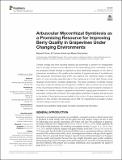Por favor, use este identificador para citar o enlazar a este item:
http://hdl.handle.net/10261/192885COMPARTIR / EXPORTAR:
 SHARE SHARE
 CORE
BASE CORE
BASE
|
|
| Visualizar otros formatos: MARC | Dublin Core | RDF | ORE | MODS | METS | DIDL | DATACITE | |

| Campo DC | Valor | Lengua/Idioma |
|---|---|---|
| dc.contributor.author | Torres, Nazareth | es_ES |
| dc.contributor.author | Antolín Bellver, M. Carmen | es_ES |
| dc.contributor.author | Goicoechea, Nieves | es_ES |
| dc.date.accessioned | 2019-10-18T09:09:49Z | - |
| dc.date.available | 2019-10-18T09:09:49Z | - |
| dc.date.issued | 2018-06-29 | - |
| dc.identifier.citation | Frontiers in Plant Science 9: 897 (2018) | es_ES |
| dc.identifier.uri | http://hdl.handle.net/10261/192885 | - |
| dc.description.abstract | Climate change and their resulting impacts are becoming a concern for winegrowers due to the high socioeconomic relevance of the winemaking sector worldwide. In fact, the projected climate change is expected to have detrimental impacts on the yield of grapevines, as well as on the quality and properties of grapes and wine. It is well known that arbuscular mycorrhizal fungi (AMF) can improve the nutritional quality of edible parts of crops and play essential roles in the maintenance of host plant fitness under stressed environments, including grapevines. The future scenarios of climate change may also modify the diversity and the growth of AMF in soils as well as the functionality of the mycorrhizal symbiosis. In this review, we summarize recent research progress on the effects of climate change on grapevine metabolism, paying special attention to the secondary compounds involved in the organoleptic properties of grapes and wines and to the levels of the phytohormones implied in the control of berry development and fruit ripening. In this context, the potential role of AMF for maintaining fruit quality in future climate change scenarios is discussed. | es_ES |
| dc.description.sponsorship | NT was the recipient of a FPU grant of the Spanish Ministry of Education, Culture and Sport. | es_ES |
| dc.language.iso | eng | es_ES |
| dc.publisher | Frontiers Media | es_ES |
| dc.relation.isversionof | Publisher's version | es_ES |
| dc.rights | openAccess | es_ES |
| dc.subject | Berry metabolism | es_ES |
| dc.subject | Climate change | es_ES |
| dc.subject | Fruit quality | es_ES |
| dc.subject | Mycorrhizal fungi | es_ES |
| dc.subject | Vitis vinifera | es_ES |
| dc.title | Arbuscular mycorrhizal symbiosis as a promising resource for improving berry quality in grapevines under changing environments | es_ES |
| dc.type | artículo | es_ES |
| dc.identifier.doi | 10.3389/fpls.2018.00897 | - |
| dc.description.peerreviewed | Peer reviewed | es_ES |
| dc.relation.publisherversion | http://dx.doi.org/10.3389/fpls.2018.00897 | es_ES |
| dc.identifier.e-issn | 1664-462X | - |
| dc.rights.license | http://creativecommons.org/licenses/by-nc-sa/4.0/ | es_ES |
| dc.contributor.funder | Ministerio de Educación, Cultura y Deporte (España) | es_ES |
| dc.relation.csic | Sí | es_ES |
| oprm.item.hasRevision | no ko 0 false | * |
| dc.identifier.funder | http://dx.doi.org/10.13039/501100003176 | es_ES |
| dc.contributor.orcid | Antolín Bellver, M. Carmen [0000-0002-4778-9147] | es_ES |
| dc.identifier.pmid | 30008729 | - |
| dc.subject.uri | http://metadata.un.org/sdg/13 | es_ES |
| dc.type.coar | http://purl.org/coar/resource_type/c_6501 | es_ES |
| dc.subject.sdg | Take urgent action to combat climate change and its impacts | es_ES |
| item.cerifentitytype | Publications | - |
| item.openairecristype | http://purl.org/coar/resource_type/c_18cf | - |
| item.grantfulltext | open | - |
| item.openairetype | artículo | - |
| item.fulltext | With Fulltext | - |
| item.languageiso639-1 | en | - |
| Aparece en las colecciones: | (ICVV) Artículos | |
Ficheros en este ítem:
| Fichero | Descripción | Tamaño | Formato | |
|---|---|---|---|---|
| Arbuscular_Mycorrhizal.pdf | 399,75 kB | Adobe PDF |  Visualizar/Abrir |
CORE Recommender
PubMed Central
Citations
11
checked on 29-abr-2024
SCOPUSTM
Citations
38
checked on 01-may-2024
WEB OF SCIENCETM
Citations
35
checked on 28-feb-2024
Page view(s)
209
checked on 03-may-2024
Download(s)
215
checked on 03-may-2024



